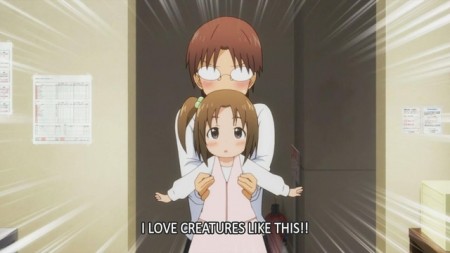Ask John: Are Moé and Lolicon the Same Thing?

Question:
I’m relatively new to manga and anime, but my friend has been in the hobby since what he calls the anime boom. He always says that anime like Lucky Star, K-ON!, and Hidamari Sketch are lolicon, and that there is no difference between lolicon and moe. Is this really true?
Answer:
From an objective perspective coming from an acknowledged proponent of anime, moé and lolicon do have a subtle but tremendously important distinction. By definition, moé evokes an asexual affection for cute things. Those fetishized things are usually young girls but can also be boys (see Mamoru-kun ni Megami no Shukufuku wo!) or even objects like glasses (see G-On Riders or Meganebu!). Series including Lucky Star, K-On, Manabi Straight, Rozen Maiden, and Hidamari Sketch not only minimize the deliberate sexual fetishization of their characters, these shows don’t even reference sex at all. Overt lolicon anime including Little Monica Monogatari, Mahou Shoujo Meruru, Imouto Jiru, and Garden the Animation deliberately depict female children as objects of sexual gratification. While moé refers to a familial variety of protective affectionate adoration that excludes sexual desire, lolicon is literally a Lolita complex – a romantic and sexual desire focused on a female child. Defending a strict distinction between moé and lolicon becomes difficult given the existence of anime including Ro-Kyu-Bu, Kodomo no Jikan, and Moetan that deliberately evoke sexual innuendo. The anime proponent may legitimately argue that shows like these satire the chaste sanctity of the moé phenomenon and force viewers to recognize a degree of sublimated sexual frustration underlying their big-brotherly affection for little-sister-type characters. While the satire may be intended to poke fun at viewers and the arbitrary delineations that viewers assert, the critic can argue that the existence of such anime merely proves that anime filled with adorable little girls yet targeted a young male viewers are immoral sexual objectification.
Speaking as a proponent of anime, I want to believe that shows like A-Channel, K-On, Ichigo Marshmallow, and Saint October are clean, innocent fun that evoke the same sense of affectionate adoration as cute cat viral videos. I want to believe that the purpose of suggestive or risque anime featuring little girls, like Ro-Kyu-Bu, Kiss x Sis, and Moetan, is to draw attention to the irrational yet compulsive psychology of die-hard anime fans, not to encourage the predatory abuse of children. A rational distinction isn’t guaranteed to persuade someone determined to be irrationally biased, and in a separation of degrees, personal perspective carries a lot of weight. In effect, someone inclined to see the worst in anime can make the point that anime which inspire affection for young girls inevitably objectify and sexualize young girls; thus moé and lolicon are the same thing because one inexorably leads to the other. I believe that a more objective and rational perspective, however, recognizes that subtle differences are still valid differences, and the reason why the terms “moé” and “lolicon” exist as different adjectives is because they do describe different varieties of anime that are fairly easily distinguishable to anyone that’s reasonably receptive to seeing the difference.
Add a Comment
You must be logged in to post a comment.


This is a debate that’s gone on for a while, which baffles me because I find the conflation of moe and lolicon absurd. I’m actually tempted to dismiss arguments that conflate the two because I feel like, most of the time, they’re either just irrational snap judgments made by people who don’t like moe and have seen something like Lucky Star or Kodomo no Jikan and are judging all moe based off of that, or they’re calculated (Though inaccurate) comparisons made by people who think moe is the worst thing ever and want more reasons for why it should be hated.
One thing I notice about this debate is that shota is almost never mentioned. While loli is often a big talking point for debates around moe, the same can’t be said for shota, which strikes me as odd, especially considering the transgressive tendency of fujoshi to involve characters from non-sexual works in sexual fantasies (Kazuma from Summer Wars, for example). The lack of mention to shota (Especially given the focus on boys and young men often involved with “moe for girls”) gives me pause in believing the legitimacy of the “moe=lolicon” argument. It really just seems to me like an effort to vilify and demonize various shows and the fans of those shows in the eyes of the rest of the fandom.
While lolicon is often moe, and some moe involves very young female characters, I’ve really yet to hear a convincing argument that places the two as one in the same.
@ Timeenforceranubis
There’s a couple of reasons why shoutacon is never mentioned, the first is mainly due to the fact that it’s not as “In your face” as lolicon is. The second reason is due to the ingrained morality that the sexualization of children is wrong no matter what the context is be it real or imaginary. The final reason is more of a hypocritical one that’s partly based on our evolutionary psychology and the society that we’ve grown up in.
All throughout history men are looked at as agents and women as objects which leads to men acting and women being acted upon. And when one has agency, that person is held responsible for their actions while an object has no such obligation because they don’t have any agency. I bring up this point because have you ever noticed that most accusations of pedophilia are actually levied at male moe & loli fans and not female ones? It’s because men are bad and shouldn’t be trusted until they prove their worth and women are automatically good and could never do wrong just because.